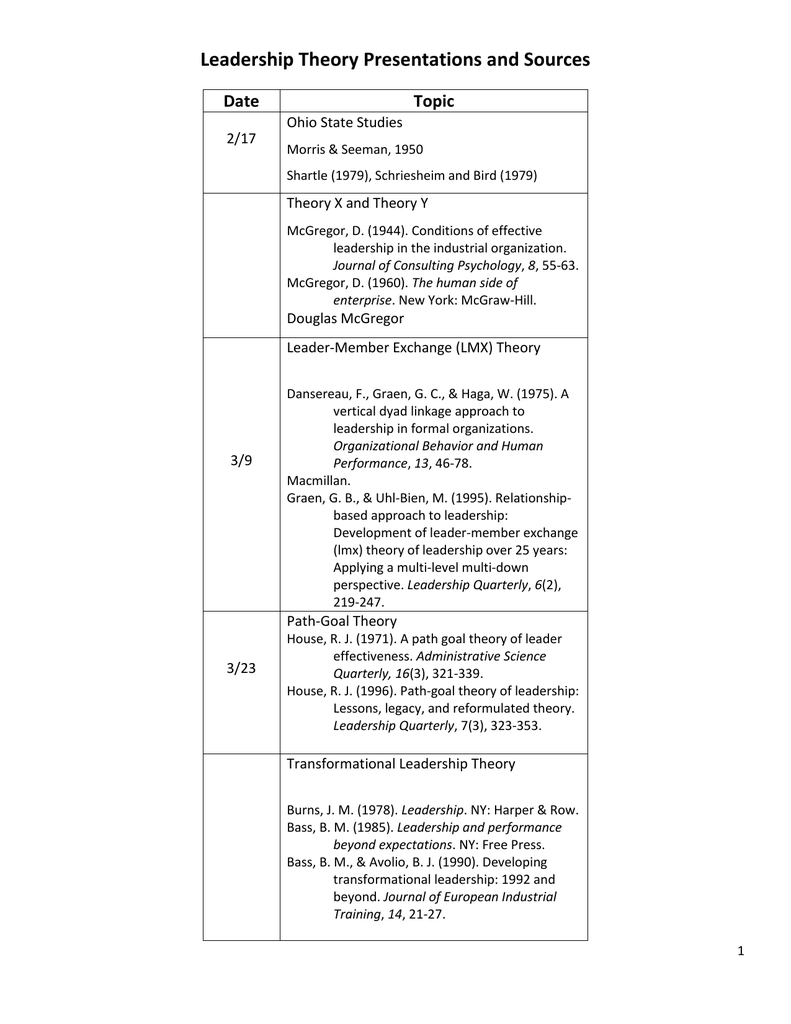
Bass 1985 Leadership
Bass’ s (1985) conceptualization of transactional and transformational leadership included seven leadership factors, which he labelled charisma, inspirational, intellectual stimulation, individualized consideration, contingent reward, management-by-exception andlaissez-faireleadership. In subsequent writings (see. Later around 1985, Bernard M. Bass further developed Burn’s theory on Leadership by adding a psychological notion to the factor. Bass implies, “The person who connects to their followers on an emotional level will be more elected as a prominent leader.” Characteristics of a Transformational Leader.

%2C445%2C286%2C400%2C400%2Carial%2C12%2C4%2C0%2C0%2C5_SCLZZZZZZZ_.jpg)
The transactional and transformational theories of leadership developed by Burns (1978) and Bass (1985) are clarified and extended by using a constructive/developmental theory to explain how critical personality differences in leaders lead to either transactional or transformational leadership styles. The distinction between two levels of transactional leadership is expanded, and a three-stage developmental model of leadership is proposed.
References
Bass 1985 Leadership And Performance
Bass 1985 Leadership Theory
- (1986) Transformational leadership, charisma, and beyond (Tech. Rep. No. 85-90). Binghamton: State University of New York, School of Management.Google Scholar
- (1985) Leadership and performance beyond expectations. New York: Free Press.Google Scholar
- (1986) Transformational leadership and the falling dominoes effect (Tech. Rep. No. 86-99). Binghamton: State University of New York, School of Management.Google Scholar
- (1978) Leadership. New York: Harper & Row.Google Scholar
- (1968) Language and mind. New York: Harcourt, Brace, & World.Google Scholar
- (1986) Leader-member exchange model of leadership: A critique and further development. Academy of Management Review, 11, 618–634.Link , Google Scholar
- (1982) The role of leadership in the employee withdrawal process. Journal of Applied Psychology, 67, 868–872.Google Scholar
- (1977) A 1976 theory of charismatic leadership. In Hunt J. G.Larson L. L. (Eds.), Leadership: The cutting edge. Carbondale: Southern Illinois University Press.Google Scholar
- (1984) Organizational leadership: The contingency paradigm and its challenges. In Kellerman B. (Ed.), Leadership: Multidisciplinary perspectives (pp. 113–138). Englewood Cliffs, NJ: Prentice-Hall.Google Scholar
- (in press) Leadership in complex systems. In Zeidner J. A. (Ed.), Human productivity enhancement, Volume 11: Organizations and personnel. New York: Praeger.Google Scholar
- (1984) Leadership: Multidisciplinary perspectives. Englewood Cliffs, NJ: Prentice-Hall.Google Scholar
- (1982) The evolving self: Problem and process in human development. Cambridge, MA: Harvard University Press.Google Scholar
- (1984) Adult leadership and adult development: A constructivist view. In Kellerman B. (Ed.), Leadership: Multidisciplinary perspectives (pp. 200–230). Englewood Cliffs, NJ: Prentice-Hall.Google Scholar
- (1985) Psychology of work behavior. Homewood, IL: Dorsey Press.Google Scholar
- (in press) Defining military character: A new perspective. Parameters: Journal of the U.S. Army War College.Google Scholar
- (1986) A metaanalysis of the relation between personality traits and leadership: An application of validity generalization procedures. Journal of Applied Psychology, 71, 402–410.Google Scholar
- (1986) Beyond imitation: Complex behavioral and affective linkages resulting from exposure to leadership training models. Journal of Applied Psychology, 71, 571–578.Google Scholar
- (1978) Systemic problem solving. In McCall M. W.Lombardo M. M. (Eds.), Where else can we go? (pp. 129–143). Durham, NC: Duke University Press.Google Scholar
- (1954) The construction of reality in the child. New York: Basic Books (First published in 1939).Google Scholar
- (1978) Leadership is a language game. In McCall M. W.Lombardo M. M. (Eds.), Where else can we go? (pp. 87–99). Durham, NC: Duke University Press.Google Scholar
- (1980) The growth of interpersonal understanding: Developmental and clinical analyses. New York: Academic Press.Google Scholar
- (1977) The leader as manager of reinforcement contingencies: An empirical example and a model. In Hunt J. G.Larson L. L. (Eds.), Leadership: The cutting edge (pp. 121–137). Carbondale: Southern Illinois University Press.Google Scholar
- (1947) Theory of social and economic organization (
, Parsons T. , Henderson A. M. Trans.). New York: Oxford University Press.Google Scholar - (1981) Leadership in organizations. Englewood Cliffs, NJ: Prentice-Hall.Google Scholar
1985 Bass Tab
- Cited By
Permissions Metrics Downloaded 33 times in the past 12 months
History Published in print 1 October 1987Information Keywords The authors thank Mary Anne Lahey, Robert Vance, Richard Klimoski, Robert Billings, and Leon Rappoport for the helpful comments on an earlier draft of the manuscript and Auburn University for its Grant-In-Aid Program which partially supported the research. Portions of this paper were completed while the first author was a Visiting Professor at Ohio State University.